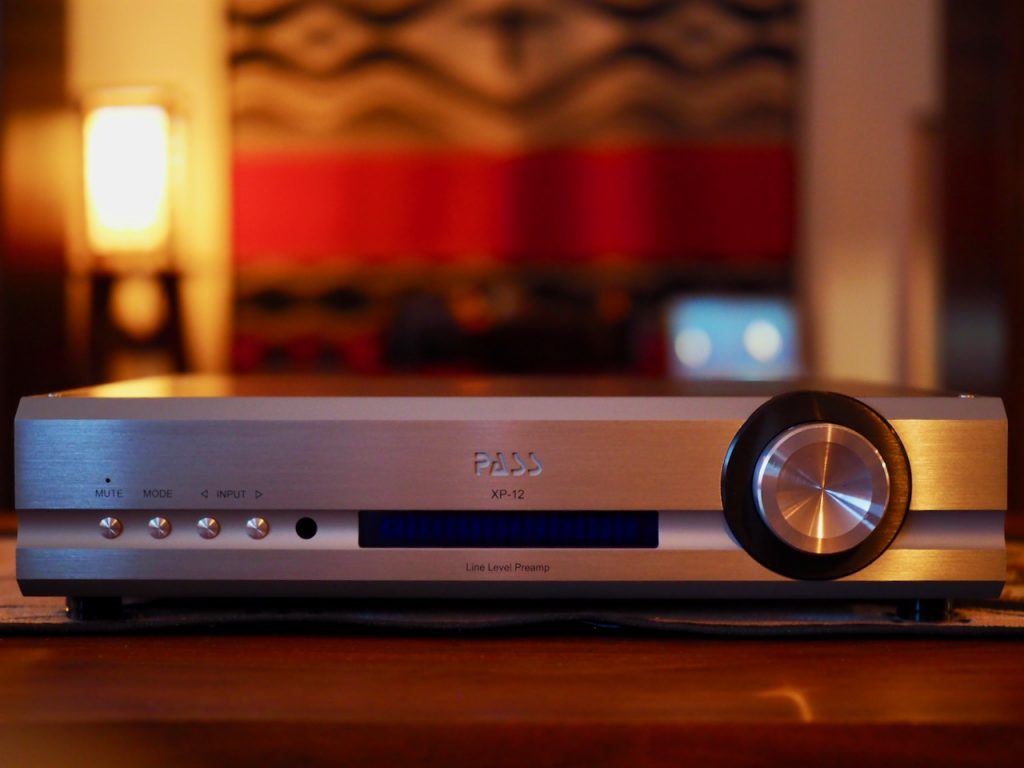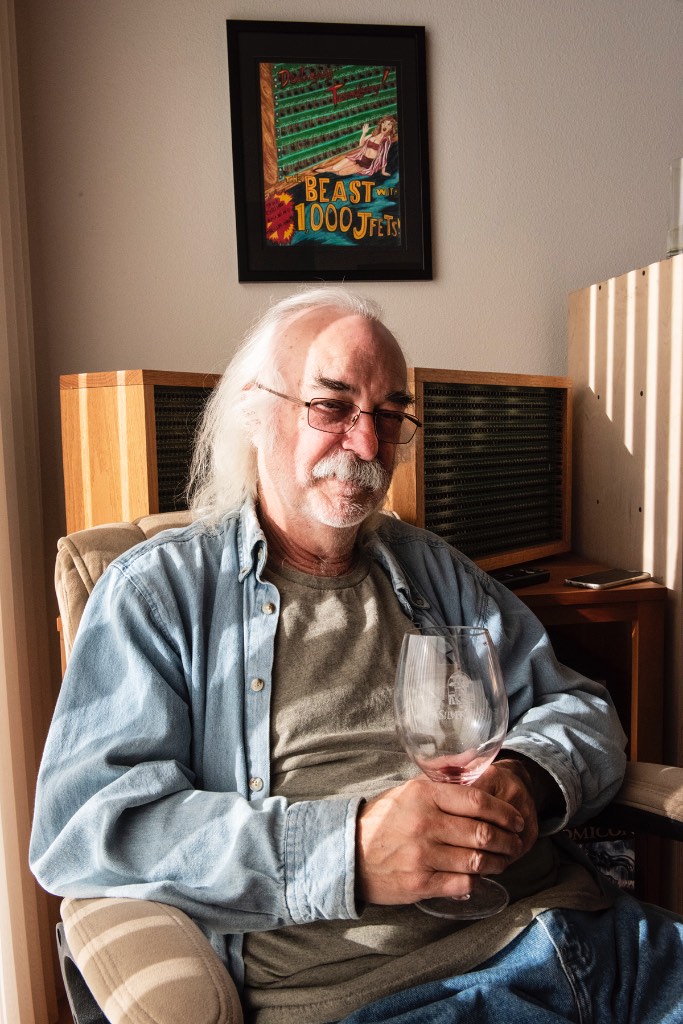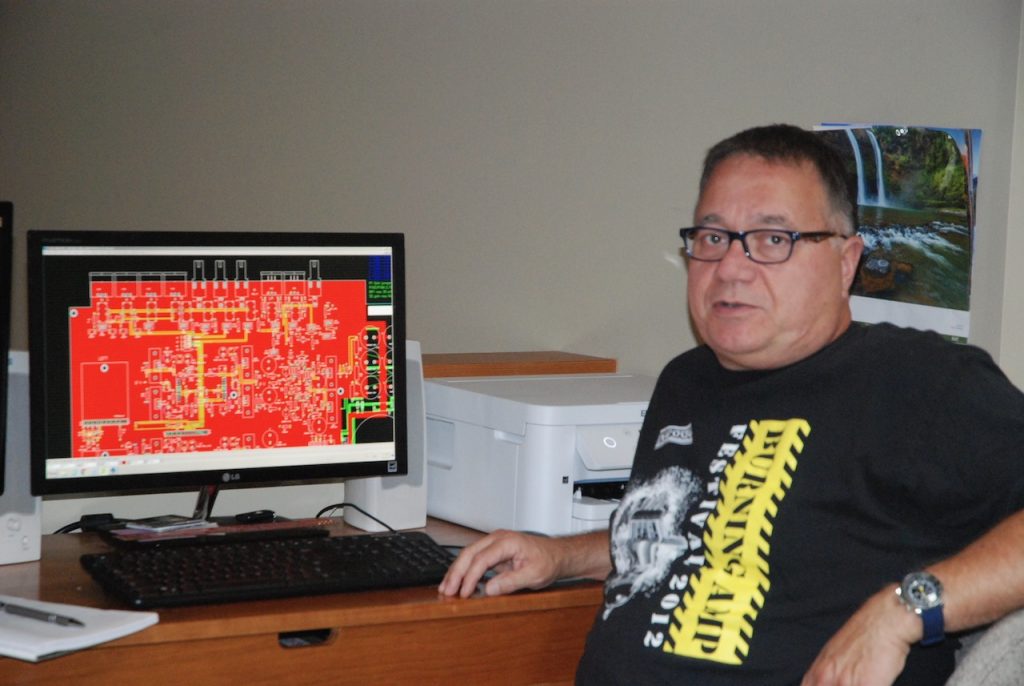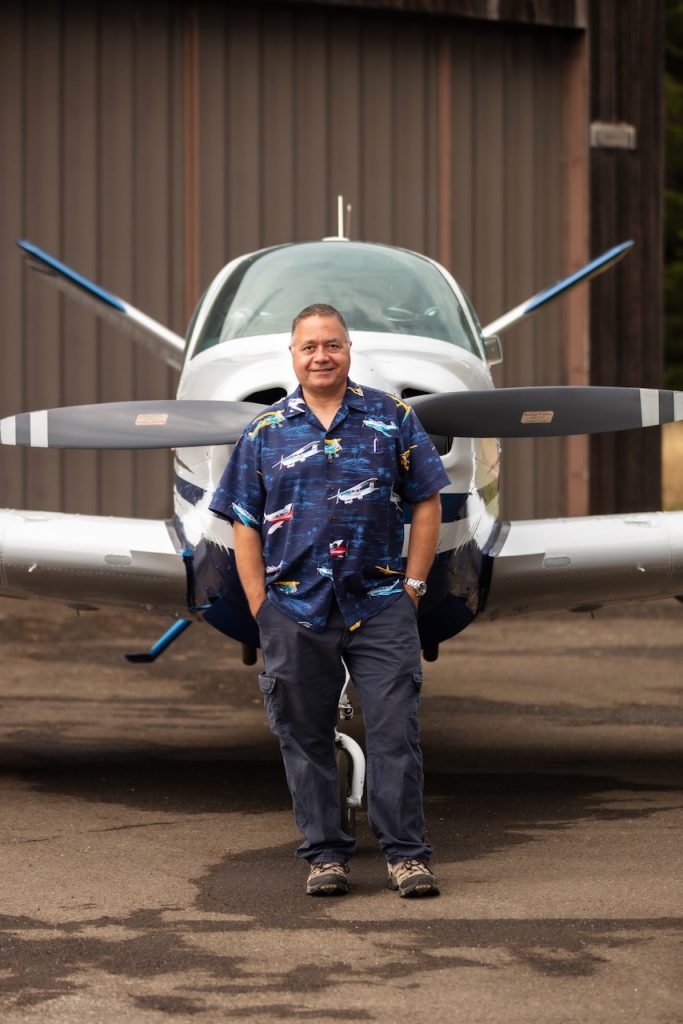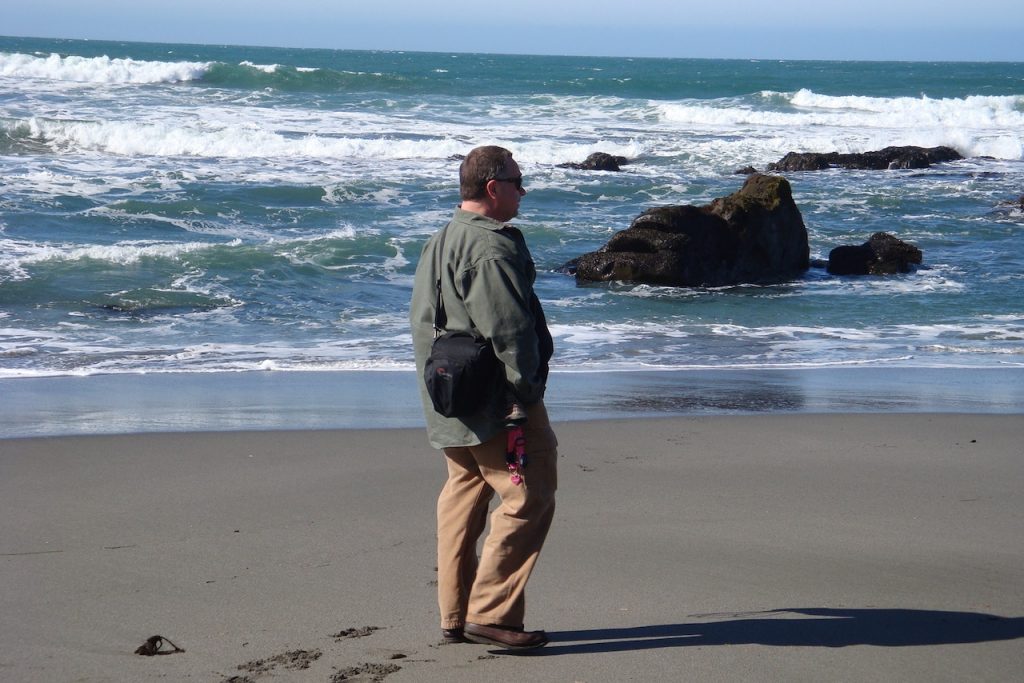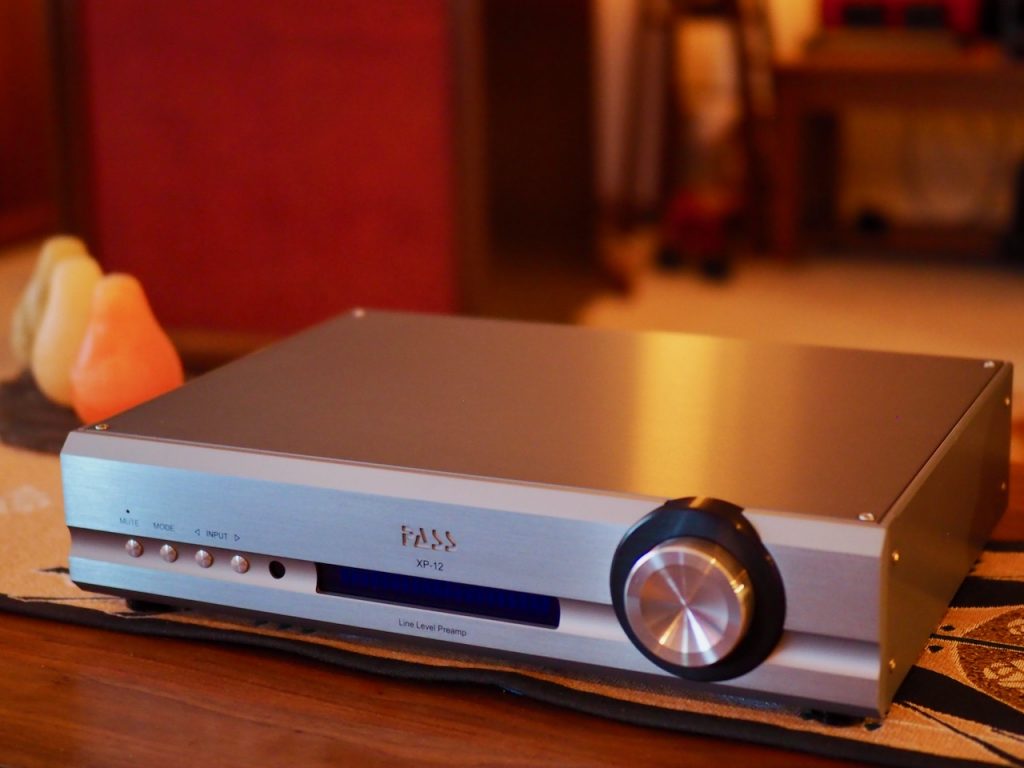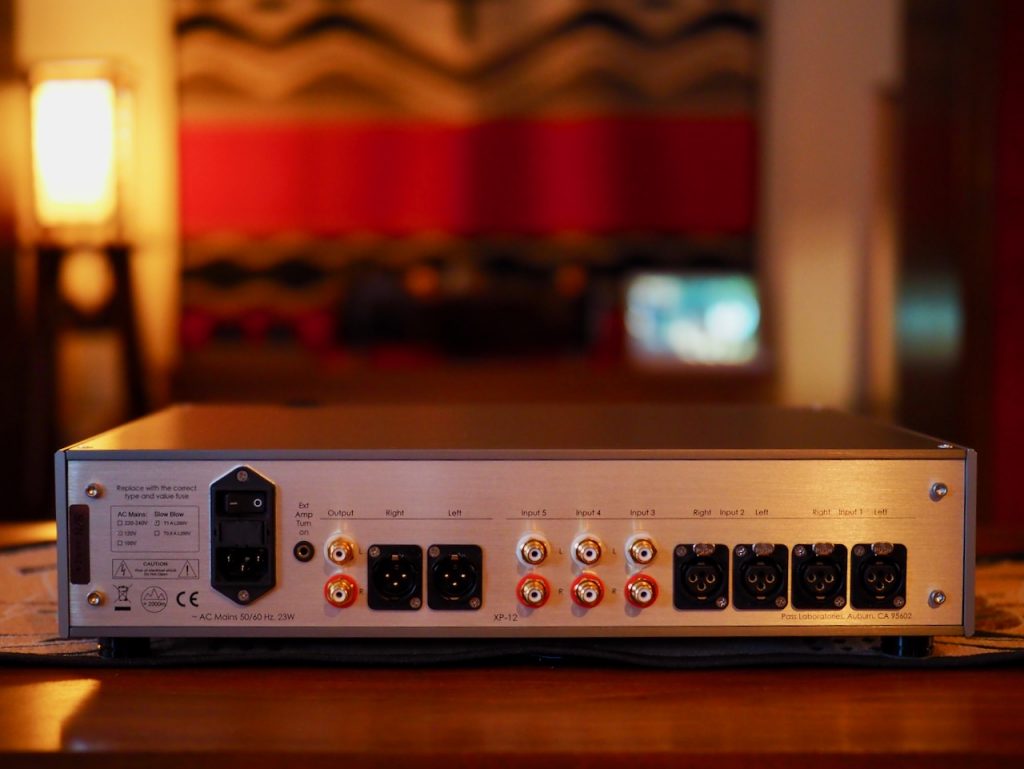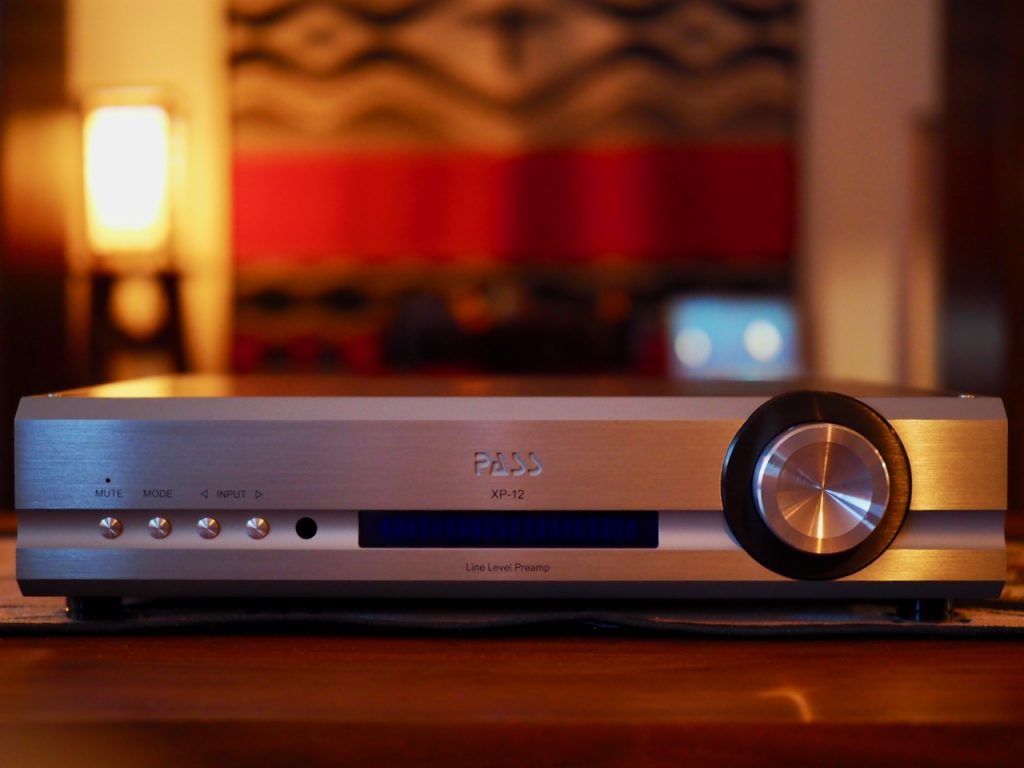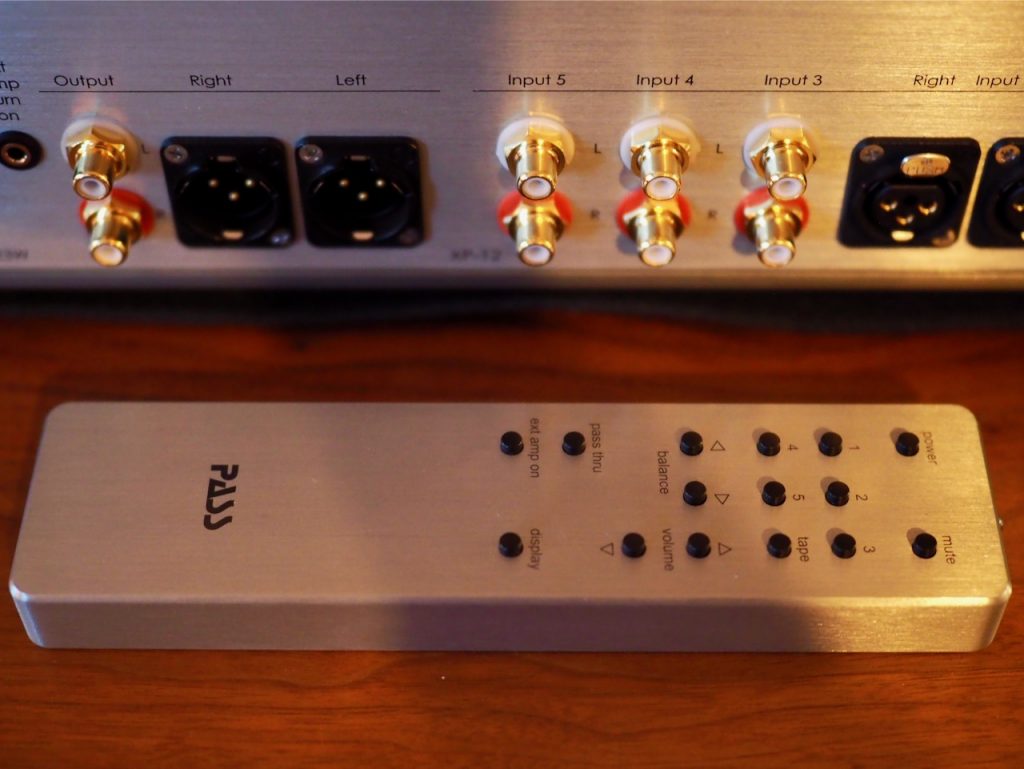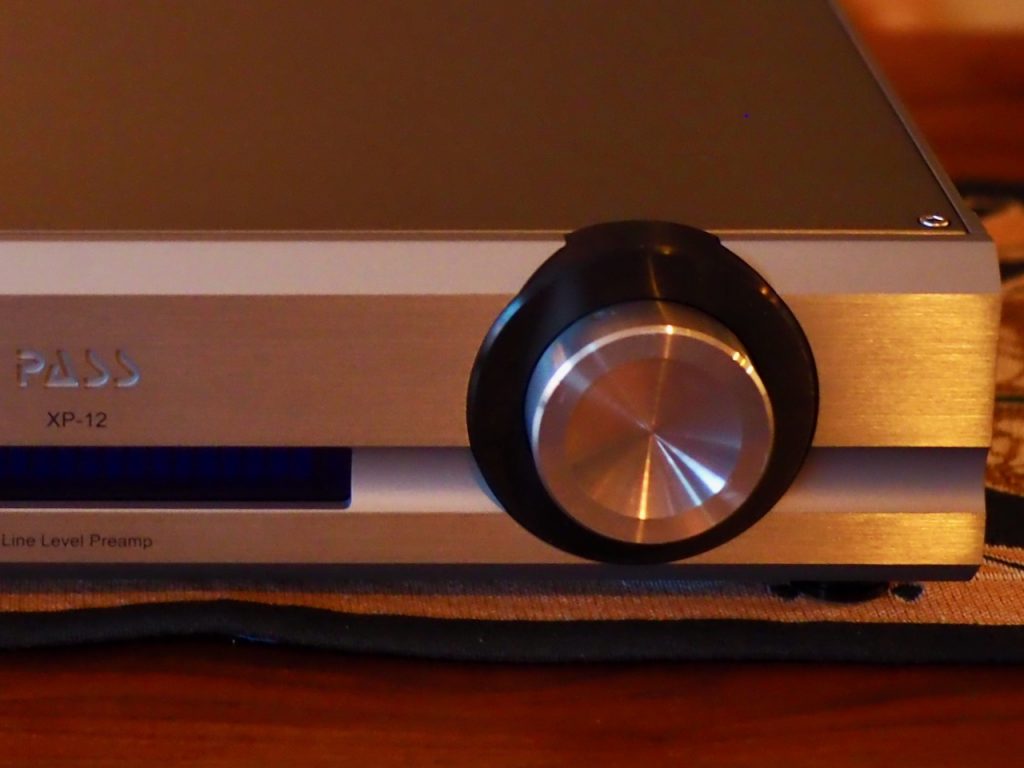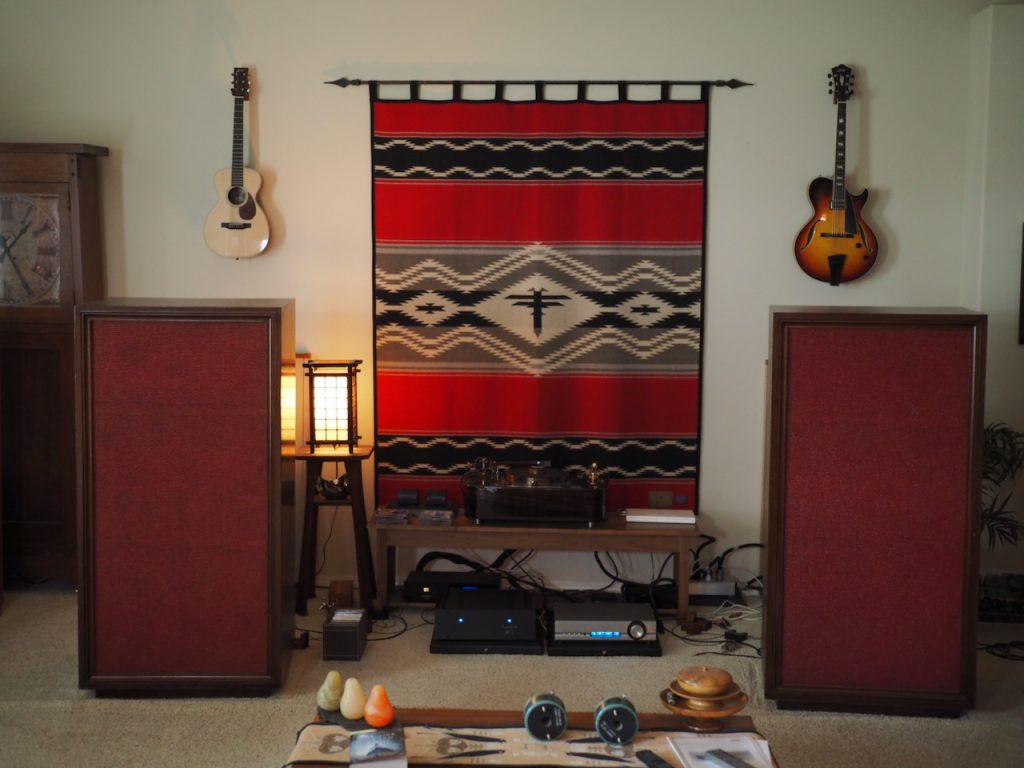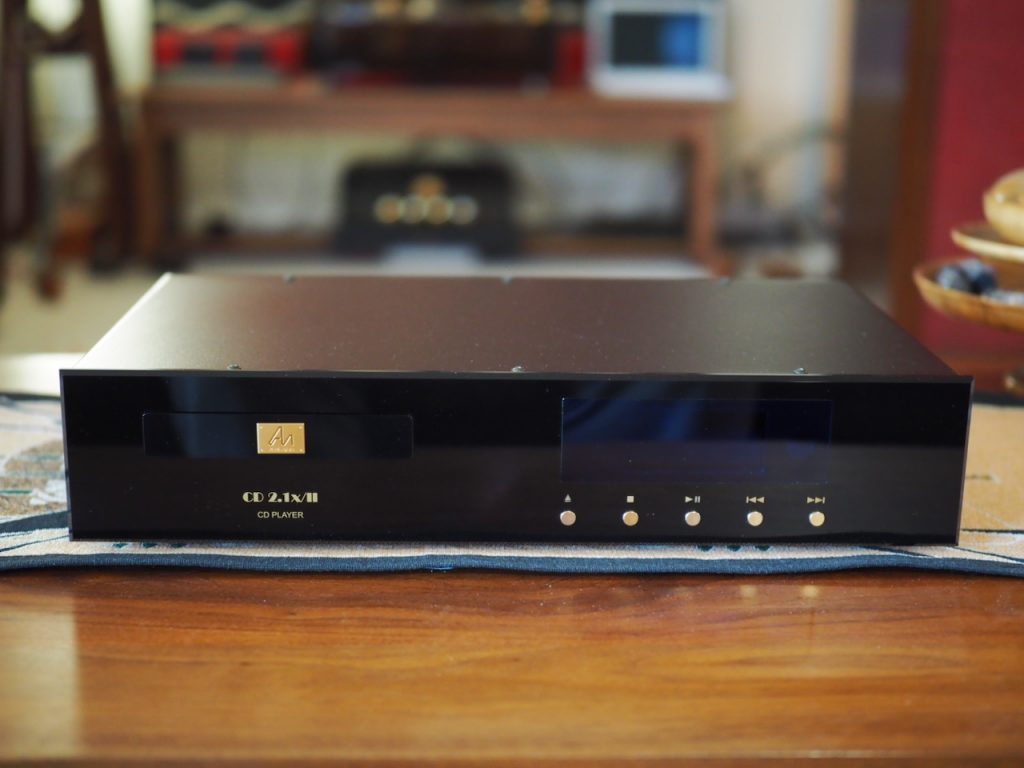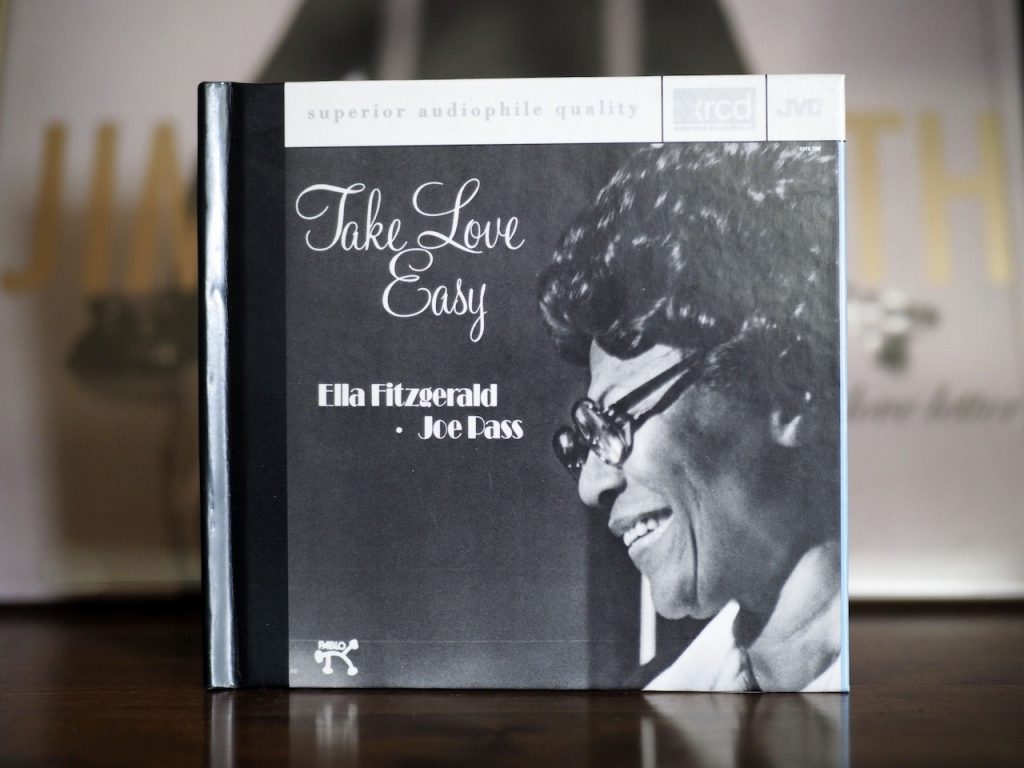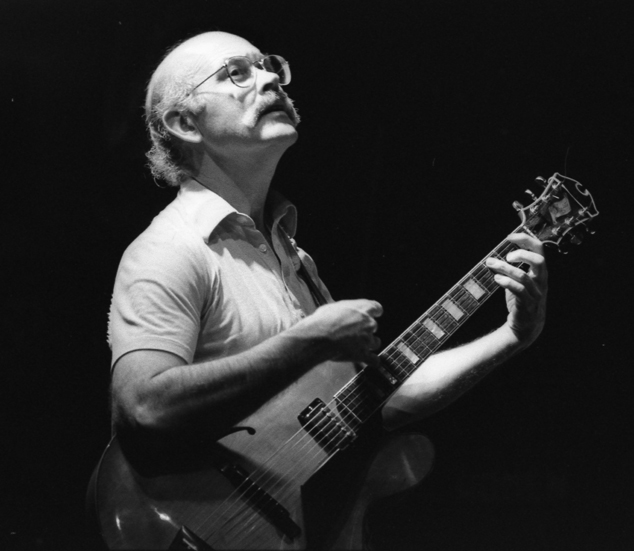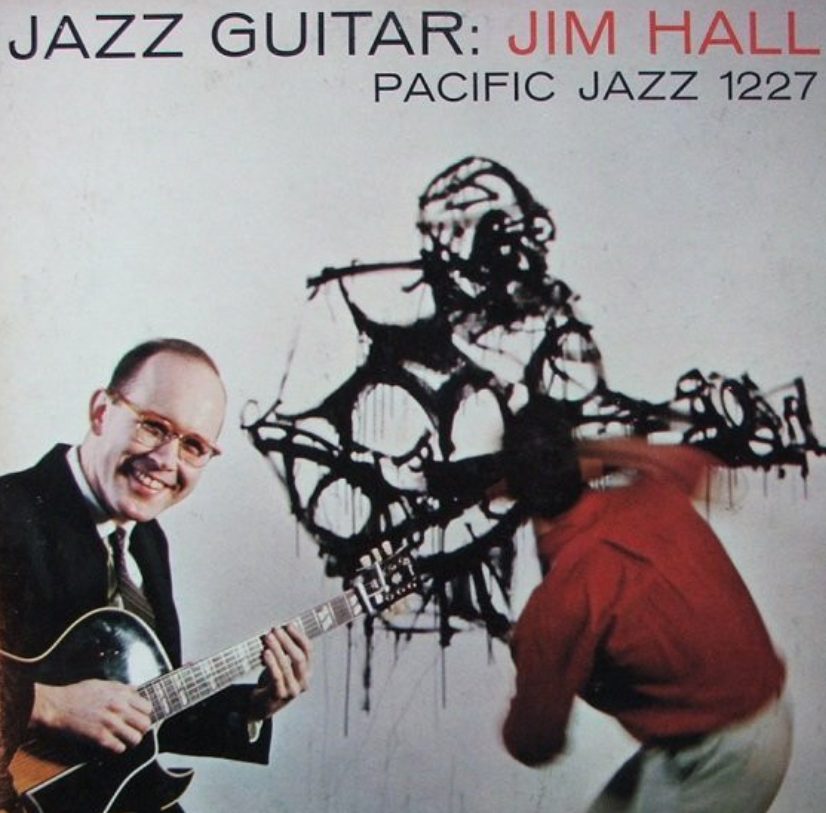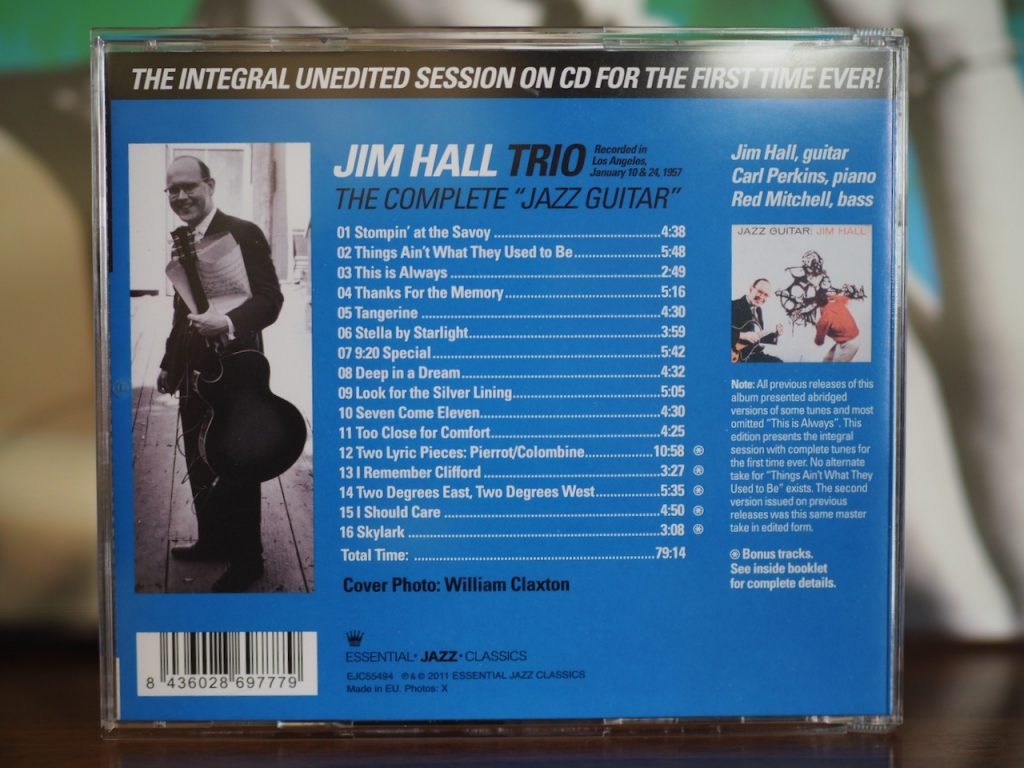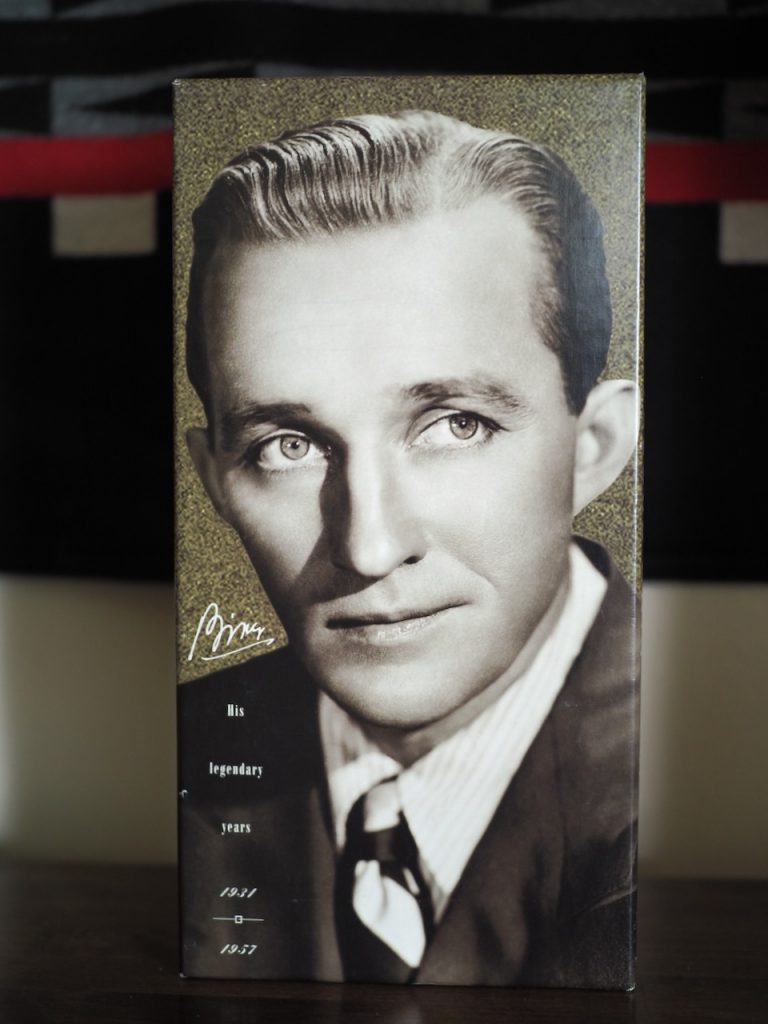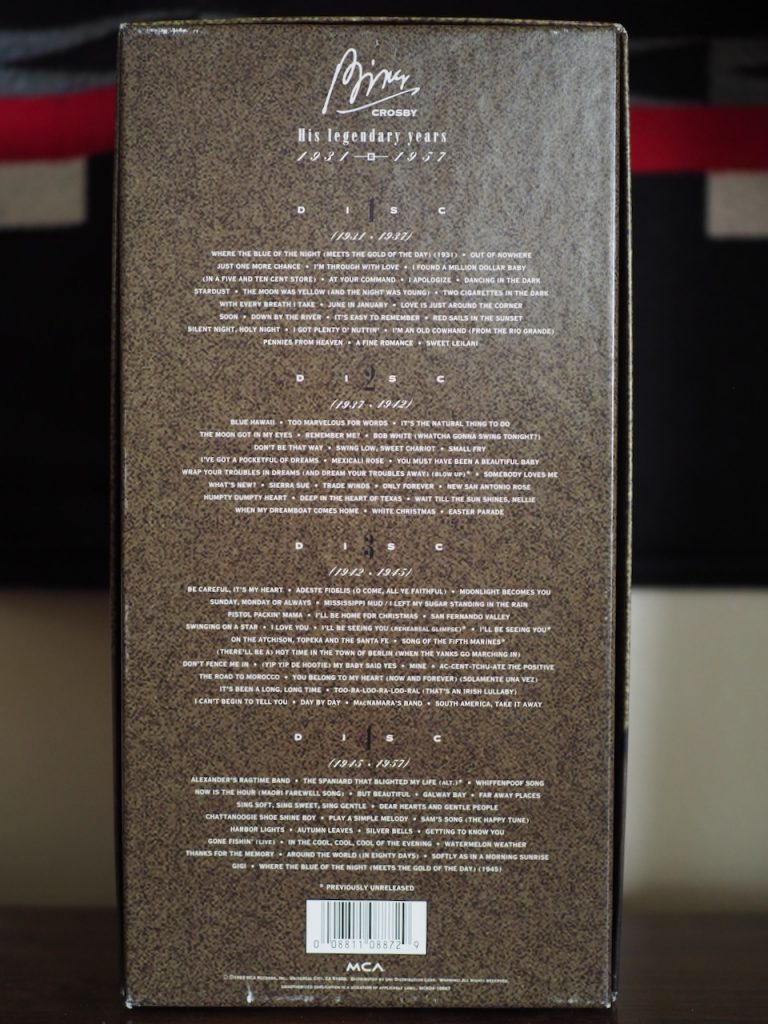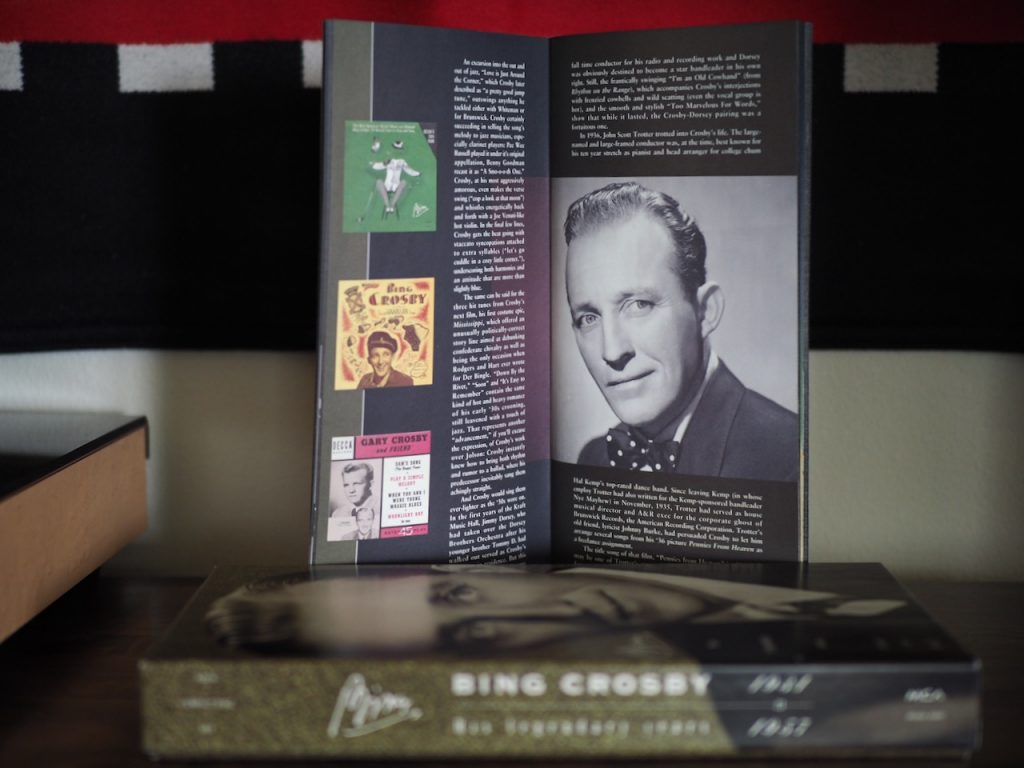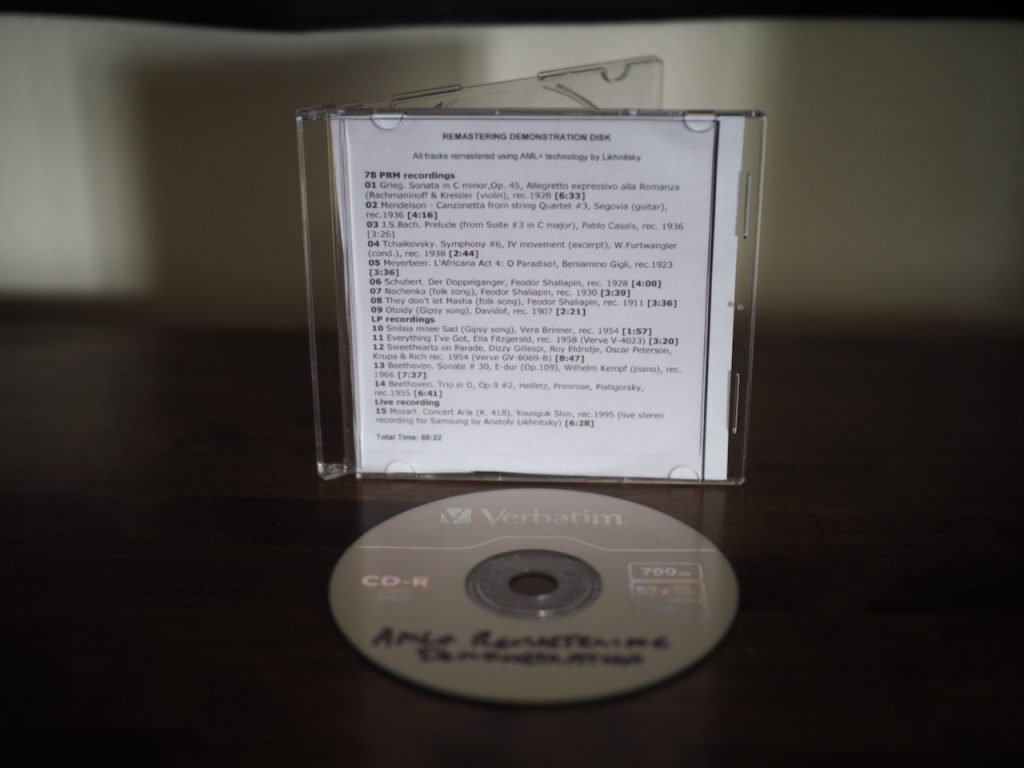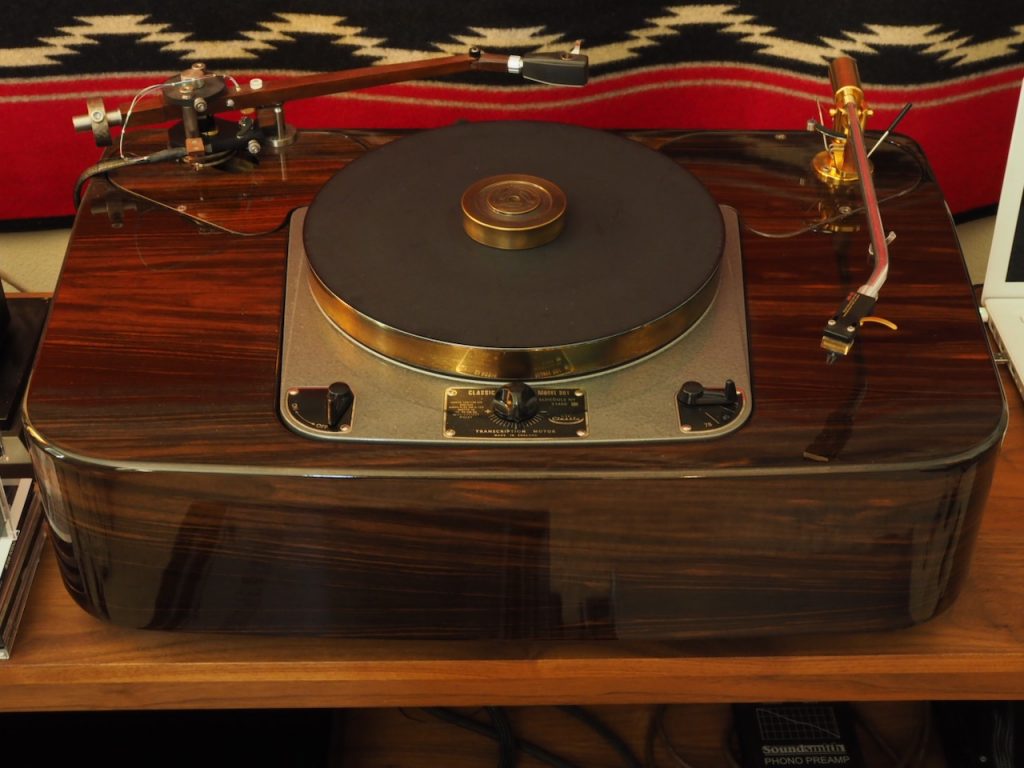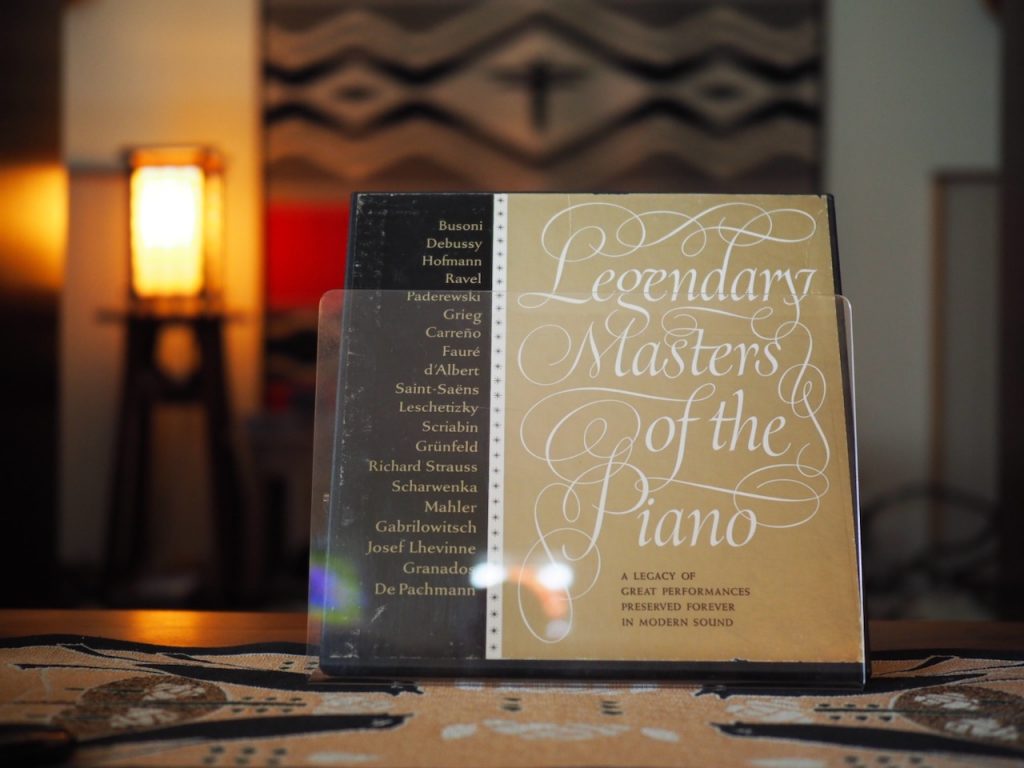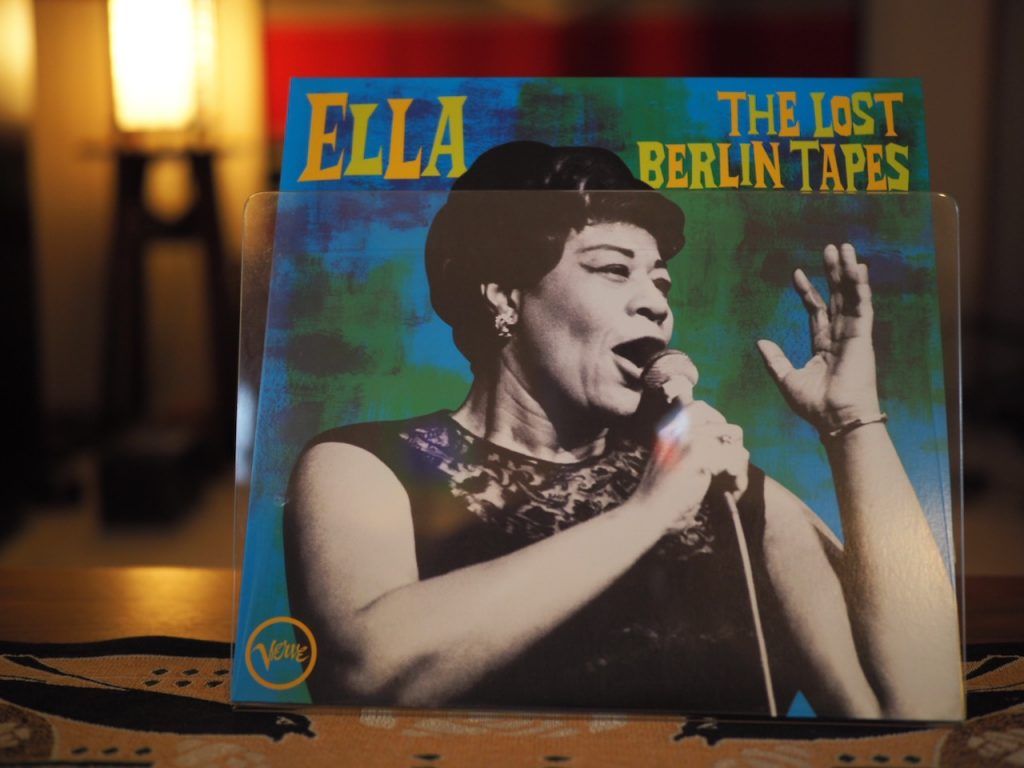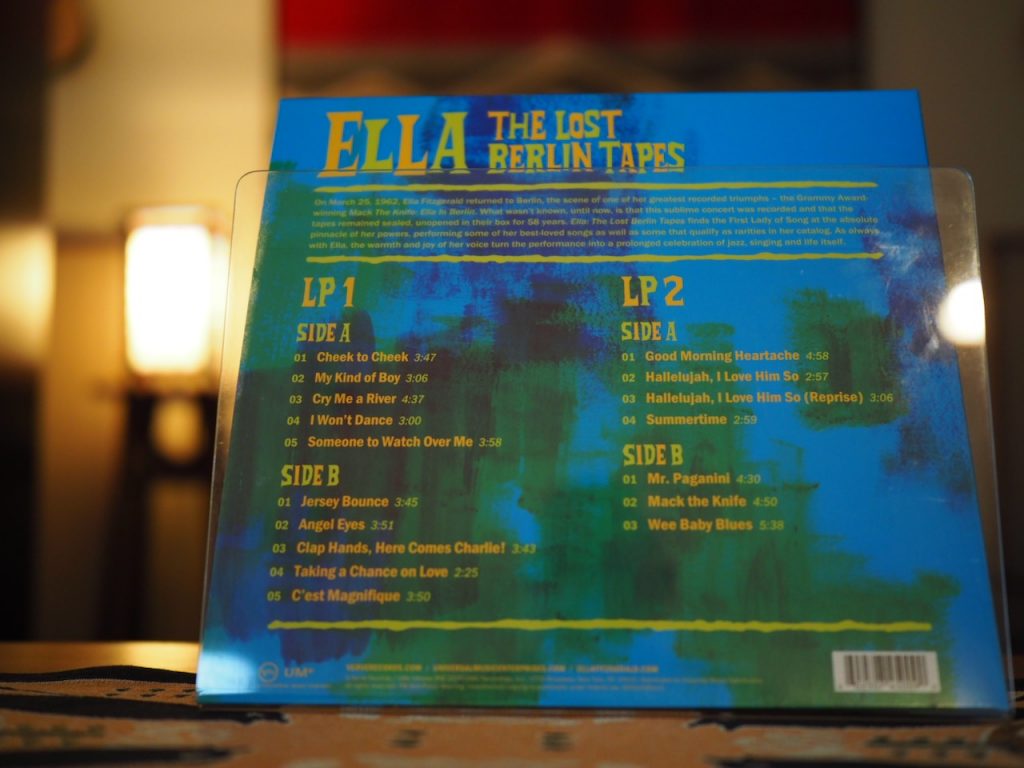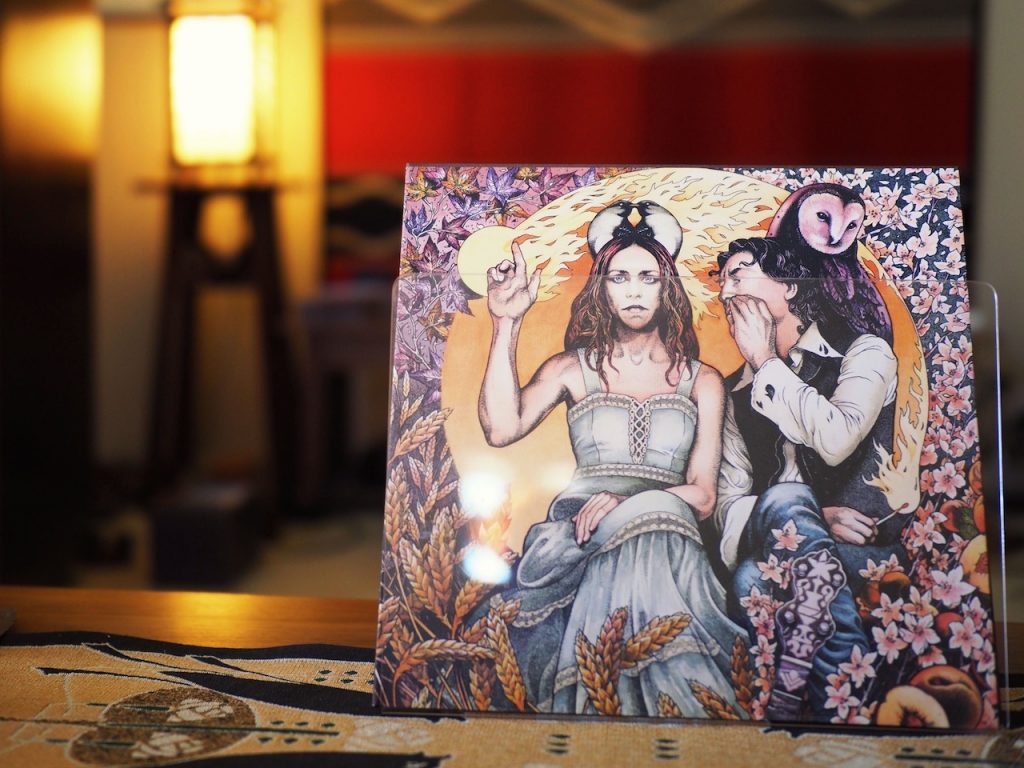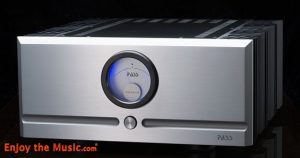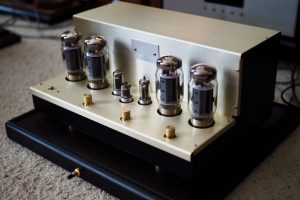I have been looking forward to telling you about the Pass Labs XP-12 line-level preamplifier, as I've found the XP-12 to make for an excellent match to the Pass Labs XA25 Class A stereo amplifier (reviewed HERE), as well the First Watt SIT-3 single-ended stereo amplifier (reviewed HERE), which are my current benchmarks for relatively affordable, lower-powered (25 watts and 18 watts, respectively), high-performance, solid-state stereo power amplifiers.
I've written extensively about the Chief Wizard of Pass Labs, First Watt, and PASSdiy, in my Positive Feedback feature articles about the First Watt SIT-3 stereo amplifier and the Pass Labs XA25 stereo amplifier.
Photograph by David W. Robinson, copyright (c) 2018, all rights reserved.
You may have assumed that Nelson designs everything for Pass Labs, but that's actually not the case.
For example, the Pass Labs preamplifiers, phono preamplifiers, and integrated amplifiers are all the design work of Pass Labs' Wayne Colburn (photo below).
Wayne's usual role is that of a "wizard behind the scenes," which is the way Wayne likes it, but in this article, I asked Nelson if he would introduce us to Wayne, who is one of Nelson's four business partners in Pass Labs, and a genius audio designer in his own right.
Wayne has been responsible for many significant audio designs over the decades (more about that in a moment), including the Pass Labs XP-12 line-level preamplifier that is the subject of this article.
A Wizard Behind the Scenes: Introduction to Wayne Colburn by Nelson Pass
"I have worked with Wayne for over 35 years. He is my good friend and also one of the four business partners at Pass Labs. Wayne designs the preamplifiers and anything which requires digital expertise. Wayne is a modest and private person, so allow me to introduce Wayne for those who want to know more about him and how he works.
"Wayne has a wide range of curiosity and practical experience in electronics and mechanics and a deep understanding of complex things. On one day you might see Wayne repairing the variable-pitch mechanism on his plane's propeller, and on another installing a battery-inverter power backup to his house.
"Wayne has some little-known history with Threshold and Pass Labs. In 1992 Wayne designed the ground-breaking DSP system for the Quadrature loudspeakers, helping to usher in a new generation of digital correction of acoustic issues.
"Arriving at Pass Labs, Wayne first upgraded the Aleph P preamplifier with remote control functionality and a completely original active volume control circuit. Wayne went on to create the classic D1 digital to analog converter, still highly prized 25 years later. Wayne also worked on the design of the Rushmore active loudspeakers, and its successor the SR1, and solely designed the SR2.
"Since then, Wayne has largely concentrated on preamplifiers.
"You might think of analog electronics as a "solved problem," and that given the current state of the art there is little improvement to be had in this field, and yet Wayne continually revisits previous designs and teases a bit more out of them—often with a newer, better, component, or a subtle refinement of topology, and occasionally with something more radical.
"These pieces all have excellent measurements before they are evaluated subjectively in long term extensive listening tests, a process that can last many months.
"Wayne's is a history of product design of over three decades, which has produced classic pieces, each enjoying a long lifespan, and eventually giving way to successor products which incrementally improves the products, reaffirming the promise of the original.
"There are not a lot of stories about Wayne in print, so here are two:
"My first Wayne story is about how I met Wayne:
"At Threshold in the 1980s, I decided to hire a technical assistant, and so I placed an ad in The Audio Amateur magazine that read something like this:
Help Wanted:
Amplifier Design Assistant
High Pay, No Work, All Glory
"You will understand that I received a number of applications, a couple from people who are now well known in the industry. Wayne was the guy who showed up with an amplifier he designed. Upon meeting Wayne, I hired him on the spot, and he started at Threshold a couple of months later.
"My second Wayne story is about how Wayne shows an uncanny ability to understand complicated technical issues:
"For many years I had a fire engine red Porsche 911, and one morning it wouldn't start. It would almost start, but then fail to. I had it towed to the Porsche mechanics, trained in Germany, and they worked on it but couldn't find out what the problem was. Wayne is not an auto mechanic, but standing there in the shop I didn't know what else to do, so I called Wayne who was a couple miles away at Threshold, and he came over to look at it.
"The schematic diagrams were up on the computer screen, and after studying them for a minute Wayne pointed and said "It's this valve here." And so, it was. The mechanics were astonished, and later he explained that this valve was added to Porsche's American products to meet emissions requirements, and was likely not part of their training in Germany."
Wayne on Wayne
I also asked Wayne if he would tell us a little about himself, how he got involved in audio, and how it came to pass—I know, a sorry pun—that Wayne ended up at Pass Labs.
"I became involved in audio by picking through electronics discarded on the curb on my walks home from school, resurrecting old radios and things like that.
"I had a brother that played guitar and he needed an amplifier, so we cobbled one together from Radio Shack parts. Later I built him a Tigersaurus kit 60-watt mono amplifier coupled to a 15" Altec driver. I put speaker cabinets together in the school wood shop with assorted drivers, and helped friends put together audio systems. This was in the prime-time of Harmon Kardon, Marantz and McIntosh.
"I went to college in Milwaukee for electronics, radio and television—as it was known back then. While I was at school in Milwaukee my brother had me repair a car amp that was from a place called Draco Labs. When I went to get parts after hours, the vice-president let me in to scrounge, and I left with the parts and a job in engineering. Draco designed the Draco CP1 tuner and a tuner for Crown. I learned a ton working there. We designed and built all kinds of stuff in addition to audio, electronic scales, metal detectors for food processing, measurement equipment, and more.
"I left Draco to move to Sacramento, California, for its better winters. I went to work for General Electric mobile radio there. This was another great place for learning and I met one of my best friends there, Robert Townsend, who is one of the smartest guys I know. We spent many evenings working on our own projects. Robert still consults for Pass Labs once in a while on projects, or I talk with him just to bounce ideas off of. I call him an Apollo era engineer because he does it once and it works.
"I then met Nelson Pass at Threshold, by responding to an ad Nelson had run in Audio Amateur magazine, when he was looking for a "Wizards Assistant." Being only half an hour away I drove up and left an amplifier I had built on his desk with my resume attached to it. I was embarrassed that my resume was done on a dot matrix printer! I met Nelson in person a few days later, was hired, and then started a few months later at Threshold. That was 1989, thirty-one years ago.
"At Threshold I worked on whatever needed to be done. Setting up the testing area and then building and testing prototypes. I did my first preamp designs here on the Forte 44 and then the T2 software and volume control. Mike Jaynes did the layout, and he is now back at Pass after years in medical electronics.
"When Nelson sold Threshold, I worked for his partner Rene Besne on his speakers. They used DSP to correct amplitude and phase, but not the room. It was complicated but worked well and received very good reviews. It was probably a bit early for that in the marketplace in of the early 1990s.
"I then joined Nelson as his first partner in 1994 at Pass Labs. Joe Sammut, and then Desmond Harrington, followed, both of them from Krell.
"These are the projects I have worked on since then at both Threshold and Pass:
"The Forte 44, the Threshold T2, the Pass Labs Aleph P preamplifier and Aleph P remote, the Adcom GFP 750 preamplifier, the Pass Labs X0 preamplifier, the Pass Labs X1 preamplifier, the Pass Labs X2.2 preamplifier, the Pass Labs X2.5 preamplifier, the Pass Labs X0.2 preamplifier, the Pass Labs D1 DAC, the Pass Labs Aleph Ono Phono, the Pass Labs X Ono Phono, the Pass Labs XP25 Phono, the Pass Labs XS preamplifier, the Pass Labs XS phono preamplifier, the Pass Labs XP15 phono preamplifier, the Pass Labs XP17 phono preamplifier, the Pass Labs XP27 phono preamplifier, the Pass Labs XP10 preamplifier, the Pass Labs XP20 preamplifier, the Pass Labs XP30 preamplifier, the Pass Labs XP12 preamplifier, the Pass Labs XP22 preamplifier, XP32 preamplifier, as well as the entire Pass Labs integrated amplifier line.
"As you can see I do mostly the line-level stuff and the software to run them.
"After 31 years at Pass Labs, we all still get along and manage to have fun.
"Nelson convinced me to delve into the DIY community, and that has been a lot of fun also.
"These are my DIY contributions: Pearl phono preamplifier, the Pearl 2 phono preamplifier, the Burning Amp 2017 WHAMMY headphone amplifier, the and the Burning Amp 2018 Linestage.
"These are fun things to build for maybe a couple hundred bucks that are pretty high performance, and fun to listen to music with. There are some very talented DIY guys all over the world.
"I consider myself quite fortunate to have turned a hobby into a good living, and to have met so many interesting people along the way."
The Pass Labs XP-12 Line-Level Preamplifier ($5800 USD)
Now that Nelson has introduced us to Wayne, and Wayne has shared a little about himself and his design work, let's take a look at the "Wayne Designed" Pass Labs XP-12 line-level preamplifier.
The Pass Labs XP-12 line-level preamplifier is the entry-level model in the lineup of Pass Labs line-level preamplifiers.
When one says "entry level", people often think that a design has been skimped on to achieve its entry level status. However, in the case of the XP-12, it is the recipient of important high-performance design features found in Pass Labs most ambitious preamplifier designs, that have been flowed down into the XP-12 to make it a high-performance design in its own right.
Like all the Pass Labs audio components, the XP-12 line-level preamplifier is beautifully designed, is built with exceptional quality, and possesses user-friendly features that I became quite fond of over time.
As you will read in a moment, the XP-12 line-level preamplifier also sounds great in terms of its musicality and visuospatial performance, and it has nicely complemented every power amplifier I have tried it with, both solid-state and vacuum tube.
Let's do a "walk around" of the Pass Labs XP-12 line-level preamplifier and explore its features.
Starting from the back of the XP-12, you can see there are five inputs, two of which are balanced XLR, with the other three inputs being RCA connectors. There are two pairs of outputs (left side), with one pair being balanced, and the other pair being RCA connectors.
Now, taking a look at the XP-12's front panel controls, from left to right you can see four buttons, the first being the mute switch, and the second a mode switch for the display so it can be toggled between bright, dim, and off. The third and fourth buttons allow for selecting the desired input.
It is worth noting that input 5 is a theater "pass through" with unity gain, for use with source components that have their own volume control, and you should read up on it in depth in the owner's manual before using it. If you don't follow the instructions in the owner's manual, and run a standard 2-volt source into it like a CD, DVD, or Blu-ray player, the output could drive your amplifier to deafening full output levels and potentially blow your speakers' drivers. You've been warned.
In the middle of the front of the chassis is an alphanumeric display, which shows the volume settings for the left and right channels, and the input selected.
The remote control has a CNC machined aluminum chassis as perfectly constructed as the XP-12 itself, with buttons for power, mute, each of the five inputs, tape, balance, volume, pass through (the theater pass through function is only available through remote control), turn-on for an external amplifier, and a button to set the display brightness level.
However, as the XP-12 owner's manual says, "Power, tape and ext. amp on (external amplifier turn-on) are not used with the XP-12. These specific control functions are for other products and have no effect on this product."
Introduced in 2017, the Pass Labs XP-12 line-level preamplifier is part of a new series of Pass Labs high-performance preamplifiers that were made possible due to advancements in circuit design and components, which allowed for significant advancements in sound quality and musicality over previous Pass Labs preamplifiers.
I asked Wayne if he'd tell us a little more about the XP-12's design:
"We are constantly working on and listening to new things and increasing our knowledge of circuits and components on sound. Eventually, we find some things worth putting into production because they are significant enough.
"I wanted the single-stage volume control from the Xs Preamp and better output drive for easier system integration. I wanted a quiet, neutral, and easy to listen to finished product.
"The XP-12 starts with a new power supply at the transformer. This is similar to the transformer we worked with a supplier on for the acclaimed HPA-1 Headphone Amp/Preamp. It uses an efficient toroidal design with both an electrostatic and Mu metal shielding, along with vacuum impregnating and epoxy fill. This gives us a very quiet transformer—both electrically and mechanically.
"The power supply circuitry itself is also lower noise and has additional filtering; a little more complicated but worth it. The XP-10 used a two-stage volume to give eighty-three 1 dB steps, whereas the XP-12 uses the single stage volume control borrowed from the Xs line preamp. This gives us one hundred 1 dB steps with lower noise and distortion while removing some signal path parts.
"The gain circuitry continues to use our favorite transistors from Toshiba, but has a larger higher biased output stage similar to the Xs preamplifier auto bias. This makes longer and multiple cable runs easier to drive, and gives us the advantage of simplifying our single-ended output circuitry while increasing performance.
"Overall, this makes for a quieter, more neutral, musical, and versatile control center for your system."
Review System
For this particular article—from speakers to source—the review system consisted of the Duelund-Altec Project "Stokowski" loudspeakers (HERE), the First Watt SIT-3 stereo power amplifier (HERE), the Pass Labs XP-12 line-level preamplifier, the Classic Turntable Company hot-rodded Garrard 301 turntable, and the Audio Note (UK) CD 2.1x/II Level Two Red Book CD player (which is next in my review queue).
For cables, I used the Duelund DCA16GA tinned-copper speaker cables (HERE), Duelund Dual DCA16GA interconnects terminated with Duelund plastic-free RCA plugs between the SIT-3 and the XP-12, and Acoustic Revive RCA Absolute FM Interconnects (HERE) between the CD 2.1x/II and the XP-12.
For power cords, I used a Sablon Audio Gran Corona (HERE) for the Audio Note (UK) CD 2.1x/II Level Two Red Book CD player, an Acoustic Revive Power Reference TripleC NCF AC Power Cord (HERE) for the Pass Labs XP-12 line-level preamplifier, and an Acoustic Revive Absolute Power Cable (HERE) for the First Watt SIT-3.
Other accessories included the Acoustic Revive RPT-6 Absolute NCF Power Distributor (HERE), which was connected to wall AC with an Acoustic Revive Absolute power cord, Acoustic Revive RAF-48 Air Floating Boards (HERE) to provide isolation for the SIT-3 and XP-12, Acoustic Revive RWL-3 Acoustic Conditioners behind the loudspeakers (HERE), Acoustic Revive RCI-3 Cable Insulators (HERE) to support speaker cables, and Acoustic Revive TB-38 Quartz Under-Boards (HERE) under the RPT-6 Absolute NCF Power Distributor and Intact Audio SUTs.
Wall outlets were a combination of Oyaide R-0 outlets, Acoustic Revive CB-1DB Receptacle Base Plates, and Acoustic Revive CFRP-1F Carbon Fiber Outlet Plates (HERE).
Listening Impressions
While I was getting familiar with the Pass Labs XP-12 line-level preamplifier in my Altec 832A Corona loudspeaker-based bedroom system during the run-in process, I listened to the XP-12 in combination with the Pass Labs XA25 Class A stereo amplifier, the First Watt SIT-3 singled-ended stereo amplifier, and the Leben CS-600 push-pull vacuum tube integrated amplifier, operated in its power amplifier mode.
I found that the XP-12 to be a very amplifier-friendly preamp, and it matched well with each of those very different amplifier designs, bringing out the best qualities in each design.
That sort of user-friendliness is always a good sign, as it means that whatever sort of amplifier you choose to match your XP-12 line-level preamplifier with, you can expect it will likely be a complimentary match.
I found the Pass Labs XP-12 line-level preamplifier to be transparent, natural sounding, and musical, easily providing me with insights into the performance differences between the Pass Labs XA25 Class A stereo amplifier, the First Watt SIT-3 single-ended stereo amplifier, and the Leben CS-600 push-pull vacuum tube amplifier, for example.
Interestingly, even though the Pass Labs XP-12 line-level preamplifier was transparent and resolving, I found it to be warmer and richer sounding than I was expecting, providing the Leben CS-600 with a touch more warmth and richness than when the CS-600 was operated as a stand-alone integrated amplifier, which I enjoyed.
For the final portion of my review of the Pass Labs XP-12 line-level preamplifier, I transferred the XP-12 to my main music system, optimized around my vintage "Stokowski" Altec loudspeakers, that were custom built for conductor Leopold Stokowski, almost six decades ago now, and which were updated in the Duelund-Altec Project (HERE) with Duelund Coherent Audio CAST tinned-copper crossovers based on the Jean Hiraga Altec crossover circuit for 16 Ohm drivers.
These vintage Altec loudspeakers possess a grand sense of expansiveness, scale, effortless dynamics, vivid presence, and tonal naturalness that makes for immensely satisfying fatigue-free listening sessions.
These performance attributes combine to deliver a deep view into the musicality and artistic aspects of recordings, while providing an extraordinary sense of connection to the emotional content of music, that I just don't hear from many other loudspeakers.
The First Watt SIT-3 single-ended stereo amplifier proved to be a most synergistic match for the Pass Labs XP-12 line-preamplifier when driving the "Stokowski" Altec loudspeakers, so that's what I went with to gather more detailed listening impressions about the XP-12 for this review.
I've been writing for more than a decade about the differences between audio equipment designed for music lovers, to audio equipment designed exclusively for audiophiles, as there's big differences in listenability for those two approaches in real-world day-to-day music listening.
As a result, I get quite a lot of messages from audio enthusiasts who are music lovers that tell me they want to hear more about versatile components or systems that are adept at playing all kinds of music of varied recording quality, so that they face fewer barriers while exploring new music.
Systems voiced for audiophiles can be a little frustrating for music lovers, because they often narrow the range of what can be listened to enjoyably to a fairly small number of well-recorded albums. A hifi system with an audiophile design focus can sound quite spectacular on albums featuring superb recordings, but can be quite unpleasant to listen to with albums of average recording quality.
A number of audio manufacturers and audio dealers have shared with me that there are greater numbers of audiophiles who are also wanting more flexibility in listening to a more varied music library, so that they can settle in with for the long haul and explore more music, so in this article I thought I'd use that as one of my primary listening criteria.
As you've probably guessed from that lead-in, the Pass Labs XP-12 line-level preamplifier is one of those components that is so artfully designed and voiced, that it can address what both music lovers and audiophiles want in compelling terms.
Listening Impressions with Red Book CDs
In today's world, many listeners want a hifi that can provide high-fidelity listening from a number of popular sources, including streaming, Red Book CDs, as well as the always popular vinyl records.
So, for this article I thought it would be useful in characterizing the XP-12's performance while listening to both digital and vinyl, as the output from a digital source goes directly into the XP-12, giving a clear picture of its line-level performance attributes without the additional sonic signature from a phono preamp and its associated cabling.
I haven't had a dedicated Red Book CD player in my primary music system in quite a long time. As a result, I have not listened much to my 1000+ Red Book CD collection in ages, and until the arrival of the Audio Note (UK) CD 2.1x/II Level Two Red Book CD player, I had considered most Red Book CDs to be a lost cause for music listening based on past experiences.
However, the Audio Note (UK) CD 2.1x/II Level Two Red Book CD player, sending its output to the Pass Labs XP-12 line-level preamplifier, made Red Book CDs sound like music in a way that I didn't think was possible from that format, which has rather dramatically altered my perceptions about how capable Red Book CDs can be for music listening.
As a test for the Pass Labs XP-12 line-level preamplifier musical versatility, I thought it would be fun to see how the XP-12 performed on a tour of the digital landscape, listening to good and not so good recordings, from the various recording eras.
How well does the Pass Labs XP-12 line-level preamplifier perform playing a varied spectrum of recorded music?
Ella Fitzgerald and Joe Pass' 1973 recording, Take Love Easy is a beautifully recorded jazz album that makes it a favorite among audiophiles.
As you would expect, the music is superb, given Ella is one of the greatest jazz vocalists, and Joe is one of the greatest jazz guitarists, to have ever walked Planet Earth.
On the deluxe JVC XRCD version of Take Love Easy, the Pass Labs XP-12 line-level preamplifier easily brings out Ella's beautiful vocal shadings and dynamics.
Joe's guitar accompaniment sounds similarly gorgeous with the XP-12, and the impressive resolution abilities of the XP-12 makes it easy to hear the tone color variations of Joe's chord choices, as well as all the nuances of his impressive technique in melodic improvisation, as he accompanies Ella.
Simply speaking, in terms of capturing the musicality, and visuospatial effects of the recording process, the Pass Labs XP-12 is simply superb at both, and whether I am listening to Take Love Easy, or a myriad of other recordings that I have been listening to lately on CD, the Pass Labs XP-12 line-level preamplifier has never disappointed during the music listening experience.
One of the aspects of audio that has become increasingly important to me as I've gotten older, is how successfully a component, or a full audio system, allows me as listener to explore music from the different recording eras that my grandparents, parents, and myself, have enjoyed over the last one-hundred and forty years, or so.
Those of us of a certain age, remember hearing music from the acoustic horn recording era (1877 -1925), the electrical recording era (1925-1945), the magnetic recording era (1945-1977), and the contemporary digital recording era (mid-1970s to today), while listening to music with our grandparents and parents.
If you've become a little more nostalgic over time like I have, you want to revisit those eras of music for the fond memories they evoke, while still experiencing a satisfying listening session in high-fidelity terms.
So, it has become more important than ever for me that an audio component or hifi system can enjoyably play those many albums of various recording quality that have been produced since the beginning of the recording arts—our entire recorded musical canon.
Certain legendary vintage audio components from companies like Western Electric, Marantz, McIntosh, Altec, and others, were built during periods where people avidly listened to live music, music from earlier recording eras, as well as the their current era, and as a result those components were well-balanced designs that always seemed to get the best out of the music.
Those vintage components are still sought out by music lovers for their remarkable ability to get a satisfying music listening experience out of all kinds of music and recordings, but it is also nice to know that there are components today that also can deliver music from a wide variety of historic recorded media, like the Pass Labs XP-12.
Think about how rich our recorded music canon is from all those eras, and much of what occurred in a prior era was never re-released in a later era, well until now, that is.
Audio-Visual Conservation at the Library of Congress Packard Campus.
In the USA, the Library of Congress' National Audio-Visual Conservation Center has archived our recorded music history so that the generations that come will be able to enjoy our recorded music heritage, and of course other countries have done the same.
Humanity's entire recorded music canon is of enormous historic importance to the musical arts, and it can be immensely gratifying to become more familiar with all parts of our musical history and legacy, as a well-rounded person who appreciates music.
Recordings popular among audiophiles probably make up less than one percent of the music recorded since the beginning of the recording arts, so if that's all you listen to, you are missing much of the important recorded musical legacy that is available to us, and are depriving yourself of some truly great music that will expand your listening horizons.
I coined the term "wide listening window" to describe the ability of a component or audio system to provide an authentic and enjoyable listening experience that can span a wide range of recordings of varied musical styles and recording quality that span the history of the recording arts.
Such a component sounds superb on premium recordings of important music, like the Ella Fitzgerald and Joe Pass' Take Love Easy mentioned above, while at the same time allowing recordings of historically important music to be equally enjoyable and engaging as a musical experience.
If you are a music lover, and have an audio system that can only play about one-percent of the recorded musical cannon so that it sounds good, with the remaining ninety-nine percent sounding amusical, you're going to be an unhappy listener.
Personally, I find a component or audio system with a narrow listening window to be frustrating and irritating to listen to music with, as there's a lot of great music out there that is historically important from the different recording eras, of variable recording quality, that deserves to be heard and enjoyed as part of our recorded music legacy.
Fortunately, that "vintage sensibility" of building well rounded audio equipment that can play all types of music well is making a comeback, and there are a number of audio companies that offer audio equipment that performs impressively across the spectrum of our recorded music canon.
As Wayne stated earlier in this article, he designed the Pass Labs XP-12 line-level preamplifier to be "… a quiet, neutral, and easy to listen to finished product," which is another way of saying the XP-12 provides that wide listening window into the music that I—and many other music lovers—value and crave so much for our daily listening.
Wayne's XP-12 line-level preamplifier design has allowed me to listen to pretty much anything from any period of the recording arts, while providing deep, authentic, meaningful, and emotionally involving listening experiences that spans the spectrum of recording quality that makes up our recorded musical heritage. I think that's brilliant!
Jim Hall at Keystone Korner, San Francisco 10/29/80. Photo by Brian McMillen, shared courtesy of the Wikipedia Creative Commons Attribution-Share Alike 4.0 International license.
Let's take the great jazz guitarist Jim Hall as an example, whose Discogs discography lists 128 releases that feature Jim.
If you look at popular audiophile music vendors you might find a few of Jim's most famous releases like Concierto, the Art Farmer and Jim Hall album Big Blues, or "Live" At the Half-Note with the Art Farmer Quartet and Jim Hall, or the Charlie Haden & Jim Hall live album from Montreal International Jazz Festival, or the Undercurrent album with Bill Evans and Jim Hall.
Those are great albums to be sure, but that's only 5 albums out of 128 releases that feature Jim Hall, and yet those 123 Jim Hall releases not currently available from audiophile record vendors are also vitally important musical documents of Jim Hall's considerable talent in playing jazz guitar, and are an equally important part of our recorded musical heritage.
Take for example Jim's first album, Jazz Guitar, first released in 1957 (Pacific Jazz 1227). Good luck finding a copy of the pristine mono LP from 1957, as they're nearly impossible to find.
Yet, there is a Jim Hall release from Essential Jazz Classics in the EU that offers unedited versions of the session recordings, titled Jim Hall Trio – The Complete "Jazz Guitar," that includes all of the unedited mono transfers from that recording session, including "Too Close for Comfort" that was omitted from the original Jazz Guitar album, as well as four bonus tracks from later releases during the same period that are also superb music.
I might add that the master tapes for those sessions were lost long ago, so you are never going to get a reissue of Jazz Guitar straight from the master tapes, and this CD was remastered from first edition LPs, with the omitted session recordings coming from later releases.
Many audiophiles would scoff at such a CD release, thinking it could not be worthwhile to listen to because it wasn't sourced from the original master tapes.
Others, like me, are delighted to have this historically important document of Jim Hall's first album available on a somewhat obscure CD release, with excellent liner notes and photographs of Jim Hall, that can be bought on Amazon for less than $12 USD.
Guess what? It's a musically superb CD that documents some amazing jazz performances featuring the Jim Hall Trio that includes Carl Perkins and Red Mitchell, as well as some superb bonus tracks from the same period, featuring Jim Hall with other artists like John Lewis, George Duvivier, Connie Kay, and Percy Heath, that you are unlikely to hear any other way, underscoring the importance of having a digital source that can play Red Book CDs well.
So, what do I hear from this CD as served up by the Pass Labs XP-12?
The Complete "Jazz Guitar" doesn't have that same sort of audiophile-style of presentation that the JVC XRCD of Take Love Easy has, which was sourced from master tapes and treated with a high level of tender-loving-care during the reissue process, but through the Pass Labs XP-12 The Complete "Jazz Guitar" has all the high-fidelity musicality I could want, where the tone color, timbre, melody, rhythm, etc., are beautifully and engagingly portrayed, realistic to live music, and make for a truly inspired listening experience.
Those audiophile-style visuospatial recording artifacts don't sound as obvious on this mono transfer from LPs as they do on more typical master tape transfers marketed to audiophiles as re-releases, but the way they are presented through the XP-12 are actually closer to what you would experience in a live performance than what you would hear from most audiophile spectacular sorts of CDs, including Take Love Easy.
The Pass Labs XP-12 line-level preamplifier aced the test of superb performance on Take Love Easy, as well as on the everyday recording of The Complete "Jazz Guitar," by providing an extremely convincing musical experience from both albums.
Now for something even more challenging to the XP-12's musical versatility.
Let's go back a little further in time to the electrical recording era (1925-1945) where some truly great music was recorded during a period that spanned the Great Depression, a period immortalized in the literary masterpiece, Grapes of Wrath, by John Steinbeck.
There's a delightful CD box set, Bing Crosby, His Legendary Years, 1931 to 1957, that features recordings that include those from electrical recording era of 1925 to 1945, which is a re-release of sorts of an earlier Readers Digest vinyl box set, which I also own, thanks to a friend who spotted it and bought it for me, knowing of my love for this music.
The first disc in the box set covers Bing's recordings from 1931 to 1937, right in the middle of the electric recording era.
My grandparents and my dad were from the same area as Bing Crosby - Spokane, Washington - so they had all kinds of stories about Bing and his local escapades that I heard growing up.
As a result I grew up listening to Bing's music in my parent's home as a youngster, so this music brings back fond memories for me.
Of course the question is, how does this early music from the electric recording era fare when played back through the Pass Labs XP-12 line-level preamplifier?
We music lovers want to know.
The Pass Labs XP-12 does a bloody good job serving up an authentic musical essence of this music, and turns it into a very enjoyable listening session.
Yes, this music has distortions and a few tonal peculiarities common to that period of recording, but it also possesses a sort of direct, authentic musicality, and a joyful music-making, that sounds natural, musically correct, and is immensely fun to listen to.
I wouldn't ever want to be deprived of listening to Bing's music from this period, and the very well-designed and artfully balanced Pass Labs XP-12 line-level preamplifier allows this music to come to life in an immensely satisfying fashion.
Now for an even more difficult test of the Pass Labs XP-12 line-level preamplifier's mettle.
Let's go back in time even further to listen to some superb music from the acoustic recording era (1890s to 1924), with transfers from 78 rpm albums to CD made by the great recording engineer, Anatoly Markovich Likhnitsky.
Peter Qvortrup gave me a number of CDs with 78 transfers remastered by his friend, Anatoly Markovich Likhnitsky, to listen to, and one CD-R with some select 78 rpm and LP recordings that span the history of the recording arts.
Peter's CD-R contains 78 rpm recordings of the acoustic recording era from Otoidy, "Gypsy Song," Davidof (1907), "They Don't Let Masha," Feodor Shaliapin (1911), and Meyerbeer, "L'Africana Act 4: O Paradiso!", Beniamino Giglias (1923).
When acoustic recording sessions were conducted there were no microphones or recording electronics in existence yet, and the sound of instruments and vocals were directed into a recording horn, which vibrated a diaphragm and stylus that etched the sound waves of the music onto rotating wax discs. The whole recording chain was a couple of feet long, and there were no electronics or cables involved. A purely acoustic analog recording was the result.
So how does the Pass Labs XP-12 line-level preamplifier fare reproducing these earliest of recordings?
The Pass Labs XP-12 line-level preamplifier fares very well indeed in presenting these musical treasures from our earliest recorded history.
There is a certain directness, vivid presence, and tonal purity to these early acoustic recordings that the XP-12 reveals as quite breathtakingly musical, and comparatively speaking, some of these traits are conspicuously lacking in many contemporary recordings.
The XP-12 line-level preamplifier plays these historic music recordings back with an uncanny naturalness and beauty that is truly inspiring.
Some listeners may be troubled by the surface noise on some of these ancient recordings (although some do have impressively low noise). However, that surface noise exists in a separate dimension from the music, which I find rather easy to mentally screen out while still enjoying the music immensely, at least with equipment that emphasizes the music rather than the noise, like Wayne's XP-12 design does, for example.
I might add that Peter's CD-R also includes 78 transfers from 1928, 1930, 1936, and 1938, as well as LP transfers from 1954 up until 1995, that represents recordings from every recording era.
When I listen to Peter's CD-R I am reminded of what a glorious endowment these early recordings are, how impressive the musical performances are, and comparatively speaking, they are at least the equals of the best recordings of today for communicating the heart and soul of the music to the listener.
If you have an audio system that doesn't allow you to listen pleasurably to music that spans these recording eras, you may want to reconsider your equipment choices, as you are missing out on an incredible amount of inspired music that could be enriching your musical life.
The Pass Labs XP-12 line-level preamplifier passes this test of the different recording eras in flying colors. The XP-12 is one heck of a good line-level preamplifier, being able to play music from all of the recording eras in a thoroughly satisfying way, with great musical fidelity, while providing a deep connection to the artistry and emotional content of the music.
Listening Impressions with Vinyl
After exploring the Pass Labs XP-12 line-level preamplifier's performance by playing Red Book digital with a variety of music to establish its musical versatility, let's move on to some vinyl explorations.
This necessitates adding in a phono stage—the Soundsmith MMP3—as well as interconnects, to accommodate the output from my Classic Turntable Company hot-rodded Garrard 301, so let's see how the Pass Labs XP-12 line-level preamplifier handles that.
I should mention that I have the Pass Labs XP-17 phono stage here now getting some run-in time on it for an upcoming review. I'm still in the process of figuring out its abundance of cartridge settings, and getting an adequate amount of run-in time on it to hear it at its best, so I'll discuss its performance with the XP-12 line-level preamplifier in a future article.
In this part of my evaluation I played albums that I just wanted to listen to for their musical content, without regard to them being any kind of "test" for the XP-12 line-level preamplifier, to check out how enjoyable overall the XP-12 is for listening to music just for the fun of it.
First up for listening was my long out of print box set, Legendary Masters of Piano, which features astonishing live performances by twenty great piano masters, including Busoni, Debussy, Hofmann, Ravel, Paderewski, Grieg, Carreño, Fauré, d'Albert, Saint-Saëns, Leschetizky, Scriabin, Grünfeld, Strauus, Scharwenka, Mahler, Gabrilowitsch Lhevinne, Granados, and de Pachmann, which were recorded circa 1905!
You're probably thinking these were acoustic horn recordings given they were recorded around 1905, but they are not.
Rather, these were from recordings done on a recording device developed by Herr Edwin Welte of Freiburg, Germany, who developed one of the most remarkable recording devices ever constructed, the Welte Player recording piano, which cleverly recorded everything played on it in astonishing quality.
Welte installed his recording piano in a Rhine castle, where famed pianists such as Paderewski, Grieg, Debussy, Hofmann, and many others, would come and stay as guests, and record their music while playing the Welte piano.
Word got around about what Welte had accomplished with his recording piano, and great pianists flocked to the Rhine castle so they could put their hands to the keyboard of the Welte Player and record their compositions.
What you hear in this box set are the compositions these artists actually recorded on the Welte Player, with the rolls played back over a perfectly restored Welte Vorsetzer player on a Steinway grand piano, which was recorded to tape in the recording studio of Walter S. Heebner, a former Capitol Records executive that helped with this project.
Want to hear a grand piano in your living room played by some of the greatest pianists of all time? This is the box set to make your dream come true.
Josef Hofmann recorded Mendelssohn's Rondo capriccioso, Op, 14 on the Welte Player in 1913, and hearing him played back so beautifully on my hifi with the Pass XP-12 was quite a treat!
These recordings are truly wonderful documents of the talents of the great pianists.
Want to hear Mahler play Mahler, or Debussy play Debussy, or Fauré play Fauré?
You can on this box set, and much more, with the Pass XP-12 reliably giving beautiful insights into subtle and grand dynamic swings, variations in tempo, all with gorgeously realistic musicality, and with a weight, tone, and presence of each note played that reverberates with a life of its own.
This is a recording of a single grand piano playing, so I didn't hear imaging in the typical sense of multiple instruments, but what I did hear through the Pass Labs XP-12 was a life-size piano playing with all the tonal beauty and sophistication they are capable of, by artists of incredible talent playing inspired music, all played with an effortless ease, intimacy, in an expansive sound-field, with a liquid, vibrant, and emotionally gripping presentation.
I picked up a copy of the new Verve LP release of Ella, The Lost Berlin Tapes, a two LP set that was recently released.
This LP set was recorded at a concert in Berlin in 1962, where Ella was up on stage with only Paul Smith (grand piano), Wilfred Middlebrooks (double bass), and Stan Levy (drums).
The album notes say that Norman Granz had forgotten about the tapes after moving on to his next project, then the concert tapes were sealed in a box and stored unopened for 58 years in Norman Granz's tape collection, when they were rediscovered and released as a two LP set by Verve.
This is a fun album, with a very appreciative audience. Ella really enjoyed singing for them, and it shows. The accompanying trio of Paul, Smith, Wilfred Middlebrooks, and Stan Levy made for a more intimate setting, than say a big band would have.
The sound quality is average, and not great, but good enough. Ella's performances are great, however, so Ella fans like myself will want to have this as part of their Ella Fitzgerald collection.
So how does the Pass Labs XP-12 line-level preamplifier do with this album?
Just fine, thank you. The music as presented by the XP-12 was full of life and energy, courtesy to how well the XP-12 handles the dynamic spectrum of Ella's vocals.
The XP-12 is capable of producing a wide, deep, and nuanced soundstage, but you won't hear that on this album, for in spite of it being a stereo recording, it sounds more like "wide mono" than stereo. A "wide mono" style of presentation isn't really a bad thing if you're into it for the excellent music on this album, although some audiophiles might be disappointed by that aspect of the album.
With Ella, The Lost Berlin Tapes, even though the recording isn't the greatest, the Pass Labs XP-12 line-level preamplifier turns it a wonderful listening experience by delivering an engaging musical performance that the sound quality of the LPs doesn't detract from.
It's that "wide listening window" attribute that the XP-12 possesses at work, one that doesn't sacrifice musicality at the expense of audiophile-style sonics, and one which provides an enjoyable, easy to listen to, presentation of music with LPs that might not be the best recordings on Planet Earth.
I'm not referring to just Ella, The Lost Berlin Tapes, in the comment above, but to the many albums I have listened to with the XP-12 that are of just average quality, yet the XP-12 turns them into an enjoyable musical event.
It really was a treat to hear Ella singing live, with such a great selection of songs, and in such an impassioned fashion on Ella, The Lost Berlin Tapes.
I've enjoyed Gillian Welch and David Rawling's LP of The Harrow & The Harvest immensely, both for the excellent musicianship, and for its excellent recording quality.
One thing The Harrow & The Harvest does from a hifi perspective is provide a nice test of resolution in resolving harmonies. David sings a very soft harmony along with Gillian's vocals, and if a system isn't very resolving you hear them blend together as a single voice.
That's not the case with the Pass Labs XP-12 line-level preamplifier, which unravels their vocals easily so you can hear David's contribution.
The XP-12 does a superb job of presenting Gillian's vocals with beauty, richness, and feeling, allowing the dark subject matter of Gillian's vocals to hit hard with emotional impact.
Gillian's rhythm playing on her 1956 Gibson J-50 guitar sounds realistic in timbre, as does David's lead playing on his 1935 Epiphone Olympic archtop guitar, whose arrangements and tone always enchants me.
The XP-12 presents a big sense of acoustic space from The Harrow & The Harvest, along with vivid imaging that possesses a lot of presence.
One of the things that impresses me a lot about the XP-12 is that while it has a lot of clarity and resolution, it still sounds liquid, natural, and easy to listen to, something that quite a few preamps that have a lot of clarity are resolving power fail at, often sounding analytical or bright.
Not so with the Pass Labs XP-12 line-level preamplifier, which always sounds very well balanced to me, making great recordings like The Harrow & The Harvest sound amazing, as well as wringing out the maximum musicality out of even average recordings.
Speaking of great recordings, Donald Johanos' Rachmaninoff: Symphonic Dances & Vocalise, with the Dallas Symphony Orchestra, is a case in point.
This is a superb recording of superb music that has been lauded by every music critic since its release, as it really is something special.
My version is the Analogue Productions 45rpm release, and it is just as amazing as you would expect for a release coming from Chad Kassem.
The strings, for example, sound well resolved and utterly natural. No wiry and forward sound here, this is about as close as you get to live orchestral string sound in your living room.
The XP-12 also provides a nicely wide and deep soundstage, with superb imaging, so there's lots to appreciate in this superbly recorded album of beautiful music.
Summary and Conclusions
As you no doubt have concluded, I found the Pass Labs XP-12 line-level preamplifier to be an extremely well-balanced design in terms of musicality, as well as the visuospatial queues of recordings.
The Pass Labs XP-12 line-level preamplifier accommodates a wide swath of music from any recording era, recording quality, or musical style, with aplomb.
On remarkable recordings of great music, the Pass Labs XP-12 line-level preamplifier makes it abundantly evident they are remarkable, yet even on lesser recordings of great music the XP-12 always seemed to get the most music possible from them as well, which just made listening to any music truly enjoyable.
The overall voicing of the Pass Labs XP-12 line-level preamplifier is that of clarity combined with natural sound, a sort of relaxed clarity and grace, along with liquidity, if you will.
The Pass Labs XP-12 line-level preamplifier blurs the distinction between vacuum tube and solid-state amplification in a tantalizing way, by offering the natural warmth, liquidity, richness, and dimensionality of vacuum tubes, while still providing lots of that solid-state resolution and clarity.
In my review system the Pass Labs XP-12 line-level preamplifier combined with the First Watt SIT-3 provided an "easy listening" presentation, as Wayne would put it, being very unfussy, and slightly warm and rich, and very dimensional.
A bonus is that being a solid-state design, the Pass Labs XP-12 line-level preamplifier has no vacuum tubes to replace, no maintenance to do, so you can just sit back and enjoy its sublime performance, along with a long service life and lots of reliability.
Then there's the great build quality, and attractive appearance of the Pass Labs XP-12 line-level preamplifier. I might add that the blue color of the XP-12's display lighting matches that of the SIT-3, and the remote is truly useful with well thought-out features that make it a joy to use.
Wayne Coburn's design of the Pass Labs XP-12 line-level preamplifier is extremely impressive, providing great performance for a preamplifier at any price, and is made all the more alluring by the fact that it is the Pass Labs entry level line-level preamplifier at a relatively affordable $5800 USD.
Highly recommended!




